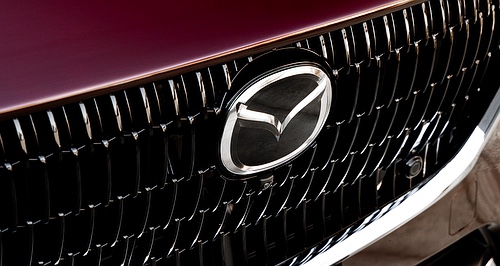News - Mazda - CX-90Mazda CX-90 diesel specs under fireShorter service intervals and lower towing capacity in question for diesel large SUV17 Aug 2023 MAZDA Australia has defended the specification and maintenance requirements of the diesel version of its CX-90 large SUV at the launch of the all-new six-cylinder model.
Like the CX-60, the diesel-powered three-row SUV curiously has a lower maximum braked towing capacity than the petrol option – 2000kg braked towing, versus 2500kg for the petrol – and also requires owners of oil-burner versions to return to the workshop for maintenance more frequently than petrol variants, with servicing intervals pegged at 10,000km, not 15,000km.
Those considerations could rule the CX-90 out for some buyers – including those rural and regional customers that Mazda Australia pointed out as being the potential targets for the diesel model.
Those types of buyers – who may live hundreds of kilometres from a dealership – could find that the additional maintenance required may stop them from purchasing the vehicle, and Mazda Australia marketing boss, Alastair Doak, said the brand is in talks with Japanese HQ to address the concern.
“It's just an engineering requirement from Mazda Corporation, and it is consistent across all of our diesel models,” he said.
“We continue to review it with Mazda Corporation, but they are looking at the conditions in Australia, which is seen as a harsh environment market, with various things - weather, dust, whatever - there's a number of factors in there.
“But obviously, in the recent past, we've increased the petrol gasoline models to 15,000 (kilometre intervals). So, it's something we review on a regular basis. We'll continue to do that. At the moment it’s 10,000km or 12 months for diesel.”
The towing question is another that is being discussed, it seems, with Mazda Australia’s team stating that the reason the petrol model has a higher towing capacity is due to the demand for that powertrain in markets like North America, where diesel is almost non-existent in passenger cars.
Further to that, the petrol engine has been developed with additional cooling measures to allow it to cope with more towed mass, and the diesel engine does not incorporate those same cooling systems, hence its lower towing rating.
Mazda Australia managing director, Vinesh Bhindi, told GoAuto that the brand will work with engineers at the Japanese headquarters to address the issue, if it turns out to be a concern for customers.
“If it's a requirement from our market that we can always go to (program manager Mitsuri Wakiie’s) team to improve the towing.
“And it's possible with investment in more cooling technology, it's not a limit of the chassis or the platform. It requires more cooling innovation to go in, which is possible,” said Mr Bhindi, who pointed out that at the very least the addition of a large diesel model with 2000kg towing capacity was a step in the right direction, having not had such an option in the CX-9 range.
However, it must be stated that the 2000kg maximum braked towing capacity is only a match, not an improvement, on the CX-8 diesel model’s ability when it comes to towing.
As Mr Bhindi pointed out, those who wish to tow anything larger than that have the option of a BT-50 ute. What a shame Mazda doesn’t offer a ute-based SUV, like the sibling brand Isuzu does with its D-Max-based MU-X.
 Read more14th of August 2023  Mazda won’t abandon affordable modelsPremium push won’t push cheaper Mazdas out, says Mazda Australia boss14th of August 2023  Long wait for Mazda CX-90 PHEVHomologation hurdles mean PHEV variants of Mazda CX-90 won’t arrive until late 202418th of July 2023  Mazda CX-60 redefines rightsizingNew six-cylinder engines, rear-wheel drive help reformulate Mazda’s premium range18th of July 2023  Mazda sales go from strength to strengthSUV and LCV models set records across the closing months of the 2022-23 financial year |
Click to shareMazda articlesResearch Mazda Motor industry news |
















Facebook Twitter Instagram